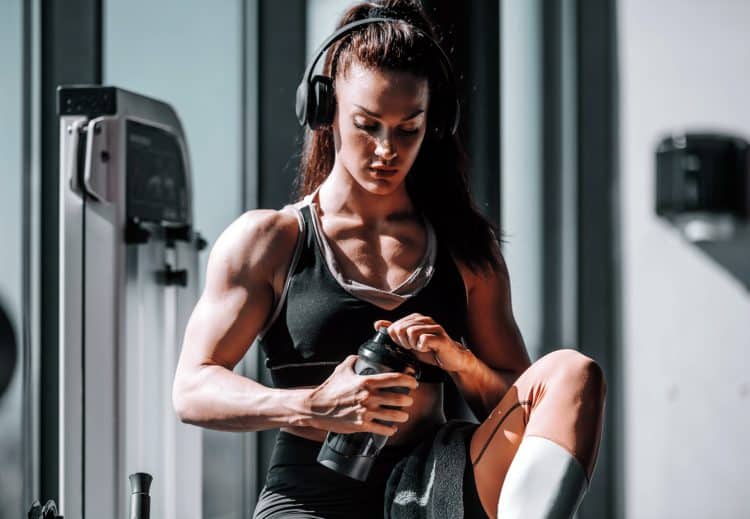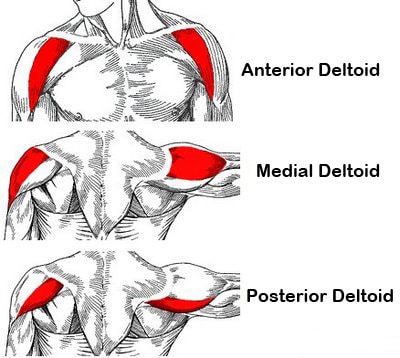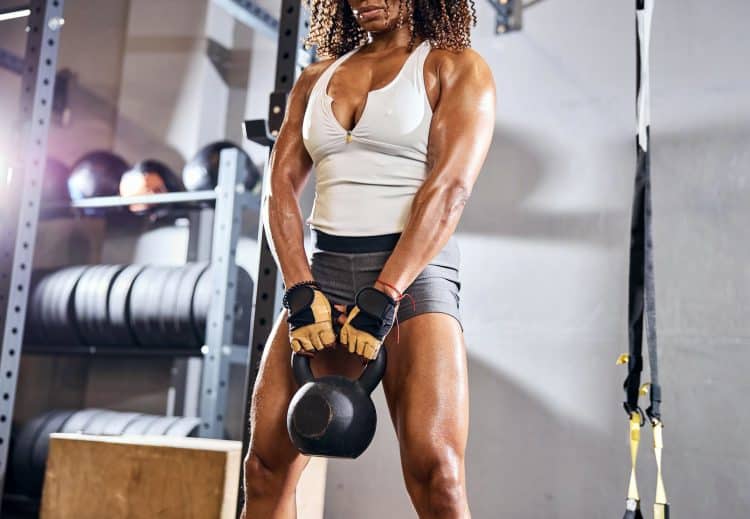Most men and more than a few women want big, broad, rounded, sculpted, well-defined shoulders. Muscular shoulders give your upper body width and contribute greatly to your V-taper.
In fact, shoulder size is so important that there is even a specific ratio between your shoulders and waist that is considered the aesthetic ideal. It’s called the golden ratio, and you can read all about it here.
The good news is that the shoulders are easy to train, tend to grow quite quickly, and are also indirectly involved in almost every upper body exercise, so developing them is seldom too difficult.
That said, not everyone wants “shoulders like boulders.” Women and some men are self-conscious about the size of their shoulders. Women especially tend to be unhappy if their shoulders are too big, believing they make them look masculine.
Of course, there is nothing wrong with big shoulders – on a man OR woman – but if you are unhappy with how your shoulders look, you may want to make them narrower.

So, if you are concerned that your shoulders are more prominent than they should be, use the following strategies to reduce them.
- Shoulder Anatomy
-
Strategies for Reducing Broad Shoulders
- 1. Stop doing lateral raises
- 2. Reduce the amount of upper body pressing in your workouts
- 3. Stop doing upright rows and shrugs
- 4. Avoid training to failure when training your upper body
- 5. Lose fat to reduce the size of your shoulders
- 6. Do more cardio
- 7. Do more lower body training
- 8. Dress to deemphasize your shoulders
- A Quick Guide to Reducing Broad Shoulders
- References:
Shoulder Anatomy
While you don’t need a degree in functional anatomy to reduce the size of your shoulders, it may be helpful to know a little more about how these muscles work so you don’t end up training them by accident!
Your shoulders, correctly called the deltoids, are made up of three sets of fibers or heads. These heads can work together, but it’s also possible to isolate each one with specific movements and exercises. That’s because each deltoid head has a unique function.

Anterior deltoids – located on the front of your shoulders, the anterior deltoids are responsible for flexion, horizontal flexion, and internal rotation of the shoulder joint.
Of all the shoulder muscles, this one is usually the biggest.
Why?
Because the anterior deltoids involved in every chest exercise you do.
Acting as a synergist or helper muscle, the anterior deltoids work with your pecs whenever you do bench presses, push-ups, flyes, dips, or crossovers. It’s a hard-worked muscle, which is why many people have big shoulders even if they don’t train them particularly hard or often.
The medial deltoids – located on the side of your shoulders, this is the deltoid head that gives your shoulders their width and creates that V-taper that so many people want.
The function of the medial deltoid is the abduction of the shoulder joint. That means it raises your upper arm up and out to your side. Needless to say, if you want narrower shoulders, you should avoid doing too much work on your medial delts.
The posterior deltoids – located on the back of your shoulders, the posterior or rear delts oppose the anterior deltoid. They are responsible for extension, horizontal extension, and external rotation of the shoulder joint.
This deltoid head is usually the least well-developed of the three. Also, it doesn’t contribute anything to shoulder width. As such, most people can continue training their rear delts without making their shoulders wider.
Trapezius – while not actually a shoulder muscle, the trapezius or traps for short “ties in” to the deltoids to make your upper body thicker. If you want narrower shoulders, you probably also want to avoid building big traps and getting “yoked.” The trapezius is the large diamond-shaped muscle that covers most of your upper back, reaching up to the base of your skull.
Strategies for Reducing Broad Shoulders
Losing mass invariably involves detraining the target muscle and is called atrophy. Most exercisers want to avoid atrophy and are more interested in hypertrophy or muscle building. But, if you want to reduce the width of your delts, it’s atrophy that you need.
Here are some effective strategies for reducing shoulder width.
1. Stop doing lateral raises

Dumbbell and cable lateral raises specifically target your medial or side deltoids. If you read the shoulder anatomy 101 part of this article, you already know this is the deltoid head that gives your shoulders their width.
Avoid triggering even more hypertrophy in your medial deltoids by dropping all forms of lateral raise from your training. Not training these muscles should allow them to detrain and shrink.
2. Reduce the amount of upper body pressing in your workouts
All pressing exercises work your shoulders. The deltoids are directly involved in all overhead presses, e.g., seated dumbbell shoulder press and machine presses, and indirectly in all chest pressing exercises, e.g., barbell bench presses and push-ups.
Avoid stimulating your deltoids by training them less often – both directly and indirectly.
For example, if your upper body workout normally looks something like this:
- Bench press – 3 sets
- Seated row – 3 sets
- Chest press machine – 3 sets
- Lat pulldown – 3 sets
- Incline dumbbell press – 3 sets
- Face pulls – 3 sets
- Triceps pushdown – 3 sets
- Biceps curls – 3 sets
- Push-ups – 3 sets
Reduce push training volume to just one set per pushing exercise.
3. Stop doing upright rows and shrugs
Upright rows are an excellent shoulder and upper trap exercise, and shrugs also hammer your upper traps. These two exercises will give you that broad, yoked appearance that some people love, but others want to avoid. Remove these exercises from your workout to prevent triggering deltoid and trapezius hypertrophy.
4. Avoid training to failure when training your upper body

Training to failure is one of the main triggers for muscle growth (1). It sends an alarm message to your muscle fibers, telling them they need to get bigger and stronger. Stop sending this signal, and they’re less inclined to grow.
So, while you can still continue to train your upper body, take care not to push your muscles too hard or perform too much volume. One or two easy sets will help maintain muscle tone without triggering hypertrophy. With less stimulation, your muscles should gradually begin to atrophy.
5. Lose fat to reduce the size of your shoulders
Muscle mass may not be the only reason your shoulders are broad; you could be storing fat there too. Pinch the skin of your shoulders between your thumb and fingers. If the skinfold feels thick, there is a good chance that fat AND muscle are making your shoulders broad.
To lose fat, you need to eat less and move more to create a calorie deficit. Use our TDEE calculator to estimate your daily calorie needs and then subtract 500 from that number. That’s how many calories you need to eat per day to lose weight.
While you’ll lose fat from all over your body, at least some of it will come from your shoulders. Unfortunately, there is nothing you can do to preferentially spot-reduce fat from your shoulders, so don’t try and burn it off with exercises that target your delts (2). If anything, shoulder-specific exercises will make your shoulders bigger, not smaller.
6. Do more cardio
Cardio is far less likely to build muscle than strength training. As such, to reduce shoulder mass, it’s a good idea to do lift less often and more cardio. Doing a lot of cardio may even cause muscle atrophy.
However, it’s probably best to avoid swimming for cardio, as most swimmers have large, powerful shoulders. Swimming is a very shoulder-dominant activity.
7. Do more lower body training

While training your thighs and butt won’t actually make your shoulders smaller, it will make them appear smaller by comparison. So, while you should be doing less upper body training to prevent shoulder hypertrophy, you put that time and energy into your leg workouts to create the illusion of smaller shoulders.
Try halving the frequency and volume of your upper body workouts and training your legs more instead. Good leg exercises include:
8. Dress to deemphasize your shoulders
Your choice of clothing can either highlight or disguise the width of your shoulders. Here are a few fashion dos and don’ts for making your shoulders look slimmer:
- Do: Go for slightly oversize or loose jackets and tops.
- Do: Wear darker colors on your upper body and lighter colors on your lower body.
- Do: Wear full skirts and wide-leg pants.
- Do: Wear V-neck tops.
- Don’t: Wear a dress with a fitted waist.
- Don’t: Wear clothes with shoulder embellishments, e.g., shoulder pads, epaulets, etc.
- Don’t: Wear strapless dresses and tops.
A Quick Guide to Reducing Broad Shoulders
While most men are only too happy to have broad, muscular shoulders, many women are not. In most cases, reducing broad shoulders involves detraining the deltoids, so the muscles undergo atrophy or shrinkage. Avoid training your shoulders, and simple lack of use should mean they begin to get smaller.
Being overweight can also lead to broader shoulders, and some people have naturally wide clavicles (collar bones), which will contribute to shoulder width. While there is nothing you can do about your underlying bone structure, losing weight and fat is usually just a matter of eating less and exercising more.
Finally, remember that how you dress can emphasize or disguise the width of your shoulders. For example, sleeveless tops tend to draw attention to shoulder width and shape. So, if you are self-conscious about the size of your shoulders, don’t dress in a way that draws attention to them.
References:
1– PubMed: Is Resistance Training to Muscular Failure Necessary? https://www.ncbi.nlm.nih.gov/pmc/articles/PMC4731492/
2– PubMed: Regional fat changes induced by localized muscle endurance resistance training https://pubmed.ncbi.nlm.nih.gov/23222084/


